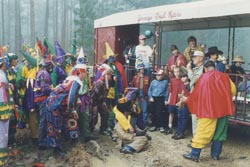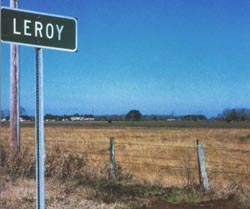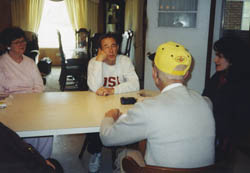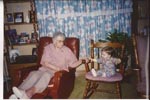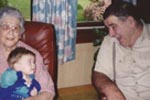Le voisinage: Evolution of Community in Cajun Country
By Dana David
Water and Community
Cajuns, descendants of the Acadians who were exiled from Nova Scotia in 1755 during the Grand Derangement, immigrated to Louisiana in the years following the Diaspora. Small isolated groups, separated by waterways and by a lack of roads, emerged from the initial settlement of the prairie in the southwestern corner of the state. The myriad of waterways that flow through Louisiana were not only a means of transportation during the 19th century but also influenced community boundaries which still exist in residual forms today. The immigrants living on the prairie were more self-sufficient than their counterparts living along the Mississippi River who had access to goods and services. Circumstances made the pooling of resources essential for economic survival. (Brasseaux 1992) As a result, frequent interaction within and between voisinage, as the small rural communities are known in Cajun French, developed over the generations. The boucherie, the échange du temps, la ramasserie, veillées, and treatments delivered at the hands of a local traiteur, or treater, are social institutions originating from the settlement patterns of early immigrants to the prairie. These exchanges still exist today although in modified forms. While a distance of two or three miles limited contact among the voisinages, the bayous determined the concentration of interaction within a given community. In fact, Ancelet, Edwards, and Pitre (1991) argue that, "the solidest bastions of Cajun life in prairie Louisiana are the clusters of small farms that still dot the landscape along major streams."
Thus, distance created by natural barriers such as water once dictated the communal activities that are distinctive to the social network of the rural voisinage. Yet, since World War II, the way of life in the prairie parishes of Southwest Louisiana has undergone an important transformation. While the War abroad triggered changes in the region, it was the transition from essentially subsistent farming practices to mechanized production, which impacted the local population (David 1995). This translated into a migration from the voisinages to the surrounding small towns, and even more significantly to jobs in the oilfield and related petro-chemical plants in Texas. The displacement of people from agricultural work to merchant oriented positions in town and elsewhere diversified occupations among Cajuns. Identification with the shared experience of the voisinage was no longer a unifying factor, and Cajun identity for individuals became a valued option (or a not so valued one depending on the situation) generated by common interests (Gold 1979). Given the economic changes in the region, the residual forms of the reciprocal exchange system communicate a notion of community. Although modified, the concept of community reflects the organization of material life in the voisinage before World War II.
Asteur: Mardi Gras and Treating as Markers of Community
There are two examples of social institutions distinctive of Cajun communal life, Mardi Gras and treating that clearly demonstrate the notion that natural waterways on the prairie determined the concentration of interaction in the voisinage. The small-scale agricultural production that characterized the pre-war Cajun communities fostered a reciprocal exchange system that nurtured social cohesion. Ancelet, Edwards, and Pitre(1992) note that: "Boucheries also nurtured a sense of community in the sense that the reciprocal system on which they were based created an interdependence between members of a community that paralleled and underscored their social ties (p.46-47)." The reciprocal exchange system mentioned corresponds to the layering of social relationships created by varied communal activities. The Courir de Mardi Gras on the prairie reflects a sense of community beyond official limits. Carl Lindahl writes: "As the riders circle the town, moving from farm to farm, they ignore corporate limits and other official loci of power to create a living map that illustrates their own sense of bonds and boundaries (1996:21)." In addition, the Courir traces out experiential boundaries of community and reinforces existing relationships, never appearing to cross a major bayou (Ancelet, Lindahl).
The small rural communities many of which lack official status, dot the prairie and form a voisinage network where relationships overlap. A series of communal activities throughout the year including money-raising benefits for those experiencing a life-crisis encourages both economic and social interdependence. An alternative way of looking at the rural prairie communities would be as centers of activity which official limits point to, not simply the margins to more urban centers (Glassie1982: 351). The prairie Mardi Gras processions influenced by natural waterways mark the physical frontier which limits and centers a group in their performance for their community. In a similar manner, the traiteur practices a specialized skill, which exemplifies the interaction between space and place important in the formation of boundaries in the voisinage. Their knowledge of prayers taught to them by older community members for ailments ranging from warts to pneumonia qualify traiteurs to administer treatments which involves praying over the sick individual. The need for a treatment originates from within and radiates outward beyond the immediate community of the traiteur. Many individuals state that any body of water between the traiteur and the patient limits the effectiveness of a treatment. Restrictions regarding treating across a body of water point to the natural boundaries of a community and seem to be giving way in light of technological advances such as the telephone. If geographical constraints like water dictated individuals' movements in the past, what presently appears to be a paradox in the administering of treatments across bodies of water and over long distances, is more importantly an indication of the evolving notion of community among Cajuns.
Place and Space
The notion of voisinage represents a sense of belonging to a place that attaches Cajuns to their native community despite the transformations that have occurred since WWII. Innovations in transportation and technology and greater mobility while enhancing the standard of living, have modified but not erased notions of community embedded in the shared experience of the voisinage. During the Mardi Gras procession, the audience is witness to and participates in the symbolic negotiation of public and private realms in community (Noyes 1995:92). The house's façade represents the sanctioned limit between the two in this communal celebration that includes followers from within and outside the community. However, the boundary of the voisinage into everyday life extends to the familial space. The communal activities such as the veillées, bals de maison, and treatments occur in this space.
The kitchen is an important sphere of interaction for community life in the homes of Cajuns and the spatial arrangement defines appropriate behavior. This room is the first that would normally be entered despite the more formal entrance at the front of the house. Community members and relatives drop by frequently, not waiting for someone to answer the knock, usually at a prescribed time of the day for the daily recount of weather and local events. And it is in this space that most of the family's daily living takes place: eating, talking, playing cards, and drinking coffee. This multi-functional room constitutes a private space where people create bonds by means of verbal exchange.
Talk among neighbors is the focus of kitchen activity and the placement of furniture and communicates familiarity (Pocius 1991: 228-29). The sorts of interactions and exchanges taking place in the kitchen translate into a conception of voisinage as an extension of the home. In a like manner, generalized reciprocity which is most dominant in intimate spheres, reverberates in other more public spheres in the form of the social and economic exchanges highlighted earlier: the kitchen is a microcosm of the voisinage.
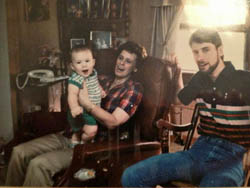
With the transformation of the economy, the social networks based on family, religious, and neighborly ties, previously linked to the shared experience of the voisinage have evolved. While the obligation of exchange for economic survival is no longer imminent, the system of reciprocity rooted in a shared work experience still occurs in socially meaningful forms. The evolution of the Cajun community on the prairies is an ongoing process. Traiteurs demonstrate creativity, which plays an important part in reshaping the voisinage. There is much talk about the influence of media in popular culture, yet, their use of the telephone in receiving requests and administering treatments constitutes a significant vernacular use of modern technology in reshaping a sense of community over long distances. The voisinage represents a fundamental network for many Cajuns and understanding how specific spheres of activity such as Mardi Gras and treating are constructed will enhance existing scholarship on Cajuns and Creoles alike.
Bibliography
Ancelet, Barry; Jay Edwards and Glen Pitre. Cajun Country. Jackson: University Press of Mississippi,1991.
Brasseaux, Carl. From Acadian to Cajun: Transformation of a People, 1803-1877. Jackson: University Press of Mississippi, 1992.
David, Marc. "Riziculture et Mardi Gras: l'organisation du travail et le carnaval rural dans la petite productiond marchande en Louisiane." Thèse: Laval , 1996.
Glassie, Henry. Passing the Time in Ballymenone. Philadelphia: University of Pennsylvania Press, 1982.
Gold, Gerald. "The French Frontier of Settlement in Louisiana : some observations on culture change in Mamou Prairie." Cahiers de Geographie du Quebec.23:59(1979) 263-280.
Lindahl, Carl. "The Cajun Country Mardi Gras and Bakhtin's Carnival Laughter," Folklore 107 (1996) 57-70.
Noyes, Dorothy. "Façade Performances: Public Face, Private Mask." Southern Folklore. 52 :2 (1995) 91-95.
Pocius, Gerald. A Place to Belong: Community Order and Everyday Space in Calvert, Newfoundland. Athens & London: University of Georgia Press, 1991.
Index of French Terms
voisinage: a small, rural community most often located near a waterway such as a bayou. Many are named after the most predominant family in the settlement. Ex. Primeauxville
Le Grand Dérangement: an Acadian term for the forced exile of the Acadians in 1755 from present day Nova Scotia.
Mardi Gras: a pre-lenten celebration with masked celebrants begging for contributions for a communal gumbo. Courir is the term used for the procession that proceeds throughout a neighborhood.
Traiteur: an individual who has received prayers from an older community or family member and who is qualified to pray and lays hands on those who seek relief from various sicknesses.
Boucherie: In the past, this was a weekly exchange of fresh meat among neighbors. The sharing of meat occurs today, but the time-line has changed.
Ramasserie: labor exchange during the harvest season.
Echange du temps: a labor exchange when intensive labor needed for a project.
Veillée: an evening visit among friends which may include cooking, playing cards, or conversation.
Bal de maison: a house dance.


